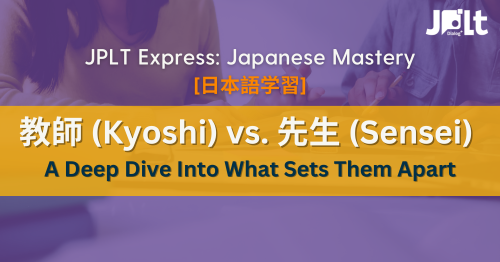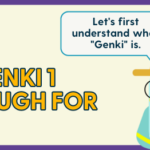By JPLT DIALOG Plus | Published on | Last updated on
When learning Japanese, the distinction between 教師 (Kyoshi) vs. 先生 (Sensei) often trips up students. While both words relate to "teacher," they are not interchangeable. Understanding their nuances is crucial for using Japanese honorifics correctly and showing proper respect.

Let's break down the core differences to clear up any confusion and help you master these essential terms.
Understanding 教師 (Kyoshi): The Job Title
The word 教師 (Kyoshi) specifically refers to a teacher by profession. It’s a job title, much like "doctor" or "engineer" in English. It’s used when you are talking about a person’s occupation, not when you are talking to them.
Breaking Down the Kanji
- 教 (kyō) – meaning "to teach" or "doctrine."
- 師 (shi) – meaning "master" or "teacher."
Together, they literally mean "teaching master," which perfectly encapsulates the role of a professional educator. You would use Kyoshi when describing someone's job, such as in a self-introduction or when referring to the teaching profession in general.
When to Use Kyoshi
Use Kyoshi in the following contexts:
1. Self-Introduction
If you are a teacher, you would introduce yourself using Kyoshi.
Watashi wa kyoshi desu. (私は教師です。) – I am a teacher.
2. Talking About a Teacher’s Profession
When discussing someone else's job.
Yamada-san wa gakkou no kyoshi desu. (山田さんは学校の教師です。) – Mr. Yamada is a school teacher.
3. Referring to the Teaching Profession
When speaking about the profession as a whole.
Kyoshi ni naru no ga yume deshita. (教師になるのが夢でした。) – It was my dream to become a teacher.
Key Takeaway
Kyoshi (教師) is a noun that denotes the profession of a teacher. It is not used as a title or a form of address. Think of it as the formal, descriptive term for an educator.
Understanding 先生 (Sensei): The Honorific Title
On the other hand, 先生 (Sensei) is a much broader and more commonly used term. It functions as an honorific title to show respect for someone who has achieved a certain level of mastery in a field or holds a position of authority and knowledge.
Breaking Down the Kanji
- 先 (sen) – meaning "ahead" or "before."
- 生 (sei) – meaning "born" or "life."
Literally, "born before," Sensei implies someone who has more experience and wisdom. While it is the standard way to address a teacher, its use extends far beyond the classroom.
Who Can Be Called Sensei?
The title Sensei is not limited to academic teachers. It's a versatile term of respect for:
- Teachers and Instructors: In schools, universities, and private lessons.
- Doctors and Lawyers: Professionals in specialized fields.
- Artists and Writers: Masters of creative crafts.
- Martial Arts Masters: For example, a karate or judo instructor.
- Politicians: Members of parliament or other high-ranking officials.
Internal Link Spotlight
The use of 'Sensei' is a fundamental part of mastering Japanese honorifics, a key component of the complex respect language known as Keigo.
Kyoshi vs. Sensei: The Core Distinctions Summarized
Let's put it all together. Here’s a table summarizing the key differences:
| Feature | 教師 (Kyoshi) | 先生 (Sensei) |
|---|---|---|
| Usage | Job Title / Noun | Honorific Title / Form of Address |
| Meaning | A person whose profession is teaching | A respected master, expert, or person with seniority |
| Who it applies to | Licensed teachers (e.g., in schools) | Teachers, doctors, lawyers, artists, martial artists, etc. |
| How to use it | When talking about a teacher's job | When talking to a teacher or respected professional |
| Example | Kare wa eigo no kyoshi desu. (He is an English teacher.) | Suzuki-sensei, arigatou gozaimasu. (Thank you, Teacher Suzuki.) |
Conclusion: Profession vs. Respect
The fundamental difference between Kyoshi vs. Sensei is about role versus respect. Kyoshi (教師) is the "what"—the job description of a teacher. Sensei (先生) is the "how"—how you show respect and address that person, along with many other professionals.
So, when you meet your Japanese teacher, you will refer to them and address them as Sensei. But if you were telling a friend about your teacher's job, you could say they are a Kyoshi. Mastering this distinction will make your Japanese sound much more natural and culturally appropriate. It's another fascinating example of how the Japanese language intricately weaves social context and respect into its very vocabulary. For more insights, you can explore other common questions like the difference between "Nihon de" vs. "N"ihon e".
Frequently Asked Questions (FAQ)
- Can you use Sensei (先生) for someone who is not a teacher?
- Yes, absolutely. Sensei (先生) is a broad honorific title used for esteemed professionals and experts in various fields, not just academic teachers. It can be used for doctors, lawyers, artists, martial arts instructors, and even politicians to show respect for their mastery and knowledge.
- Is Kyoshi (教師) more formal than Sensei (先生)?
- Kyoshi (教師) is not necessarily more formal, but it is more specific. It strictly refers to the profession of a teacher, like someone licensed to teach in a school. Sensei (先生) is a title of respect that is used in a much wider range of formal and informal situations when addressing someone directly.
- How should I refer to my Japanese language teacher?
- You should almost always refer to your Japanese language teacher as 'Sensei' (先生). For example, you would call them 'Tanaka-sensei'. Using 'Kyoshi' to address them directly would be grammatically incorrect and sound unnatural.




